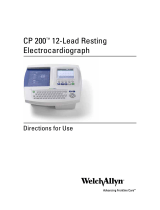
TABLE OF CONTENTS
SCOPE .................................................................................................................................................................................. 4
ECG OVERVIEW ................................................................................................................................................................... 4
ECG WORKFLOW ................................................................................................................................................................. 4
HL7 INTERFACE OVERVIEW .................................................................................................................................................. 6
HL7 INTERFACE OPERATING ENVIRONMENTS ..................................................................................................................... 7
LAN SCENARIO ............................................................................................................................................................................ 7
HOSTED SCENARIO ....................................................................................................................................................................... 8
OPERATING SYSTEM ENVIRONMENTS ............................................................................................................................................... 8
HL7 INTERFACE SETUP ......................................................................................................................................................... 9
INTERFACE TECHNOLOGY OVERVIEW .............................................................................................................................................. 10
INTERFACE CONFIGURATION CHECKLIST .......................................................................................................................................... 11
HL7 INTERFACE DEPLOYMENT ........................................................................................................................................... 12
SCHEDULED WORKFLOW CONSIDERATIONS ...................................................................................................................... 13
UNSCHEDULED WORKFLOW CONSIDERATIONS ................................................................................................................. 14
RESTING ECG MODALITY ................................................................................................................................................... 15
CLINICAL PARAMETERS OF INTEREST .............................................................................................................................................. 15
DISPLAYABLE REPORTS ................................................................................................................................................................ 15
ECG REPORTING TEMPLATE ......................................................................................................................................................... 16
HL7 DEFINITIONS ............................................................................................................................................................... 17
COMMON HL7 MESSAGE SEGMENTS................................................................................................................................. 17
MSH – MESSAGE HEADER SEGMENT ............................................................................................................................................ 18
EVN – EVENT TYPE SEGMENT ...................................................................................................................................................... 18
PID – PATIENT IDENTIFICATION SEGMENT ...................................................................................................................................... 19
PV1 – PATIENT VISIT SEGMENT .................................................................................................................................................... 20
PD1 – PATIENT ADDITIONAL DEMOGRAPHIC SEGMENT ..................................................................................................................... 21
ADT (ADMIT, DISCHARGE, TRANSFER) MESSAGES ............................................................................................................. 22
ADT MESSAGE SEGMENTS .......................................................................................................................................................... 23
MRG - PATIENT MERGE REQUEST SEGMENT .................................................................................................................................. 23
ORDER MESSAGES ............................................................................................................................................................. 24
ORC – COMMON ORDER SEGMENT .............................................................................................................................................. 25
OBR – OBSERVATION REQUEST SEGMENT ...................................................................................................................................... 26
RESULT (ORU) MESSAGES .................................................................................................................................................. 27
(MSH) MESSAGE HEADER ........................................................................................................................................................... 27
(PID) PATIENT IDENTIFICATION ..................................................................................................................................................... 28
(PV1) PATIENT VISIT .................................................................................................................................................................. 29
(ORC) COMMON ORDER ............................................................................................................................................................ 30
(OBR) OBSERVATION REQUEST .................................................................................................................................................... 31
RESTING ECG EXAMPLE MESSAGE ................................................................................................................................................ 32
RESTING ECG OBX SEGMENT DEFINITIONS .................................................................................................................................... 32
RESTING ECG OBX SEGMENT IDS ................................................................................................................................................. 42
RESTING ECG SUMMARY STATEMENT CODES .................................................................................................................................. 42


























